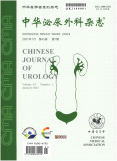摘要目的:探讨后组肾盏的分型及临床价值。方法:回顾性分析2020年4月至2021年6月武汉大学人民医院行CT尿路造影(CTU)检查的640例患者的临床资料。男320例,女320例;年龄(52.4±11.9)岁。患者两侧均有肾,501例集合系统正常,139例有轻度积水。对患者的CTU图像进行三维重建,以脊柱为标记在立体空间旋转集合系统图像,模拟俯卧体位。采取两人阅片方式,观察俯卧位肾盏的影像学形态,统计左、右侧各640个肾后组肾盏的分型。依据肾盏形态及其对手术通道建立的影响,将后组肾盏分为3个类型。壶腹型:肾盂形如壶腹,肾盂直接与杯口状肾小盏相连,没有明显的肾大盏。经典分支型:≥2个肾大盏呈分支状汇集形成肾盂。细长分支型:肾大盏呈分支状,至少有1个肾大盏轴线长度≥0.9 cm且盏颈宽度≤0.3 cm。依据后组肾小盏从属肾大盏的关系,又将经典分支型分为a、b、c 3种类型,包括7个亚型。仅来源1组肾大盏为a型,同时来源于2组肾大盏为b型,同时来源于上、中、下3组肾大盏为c型。a型包含3种亚型,仅来源于上组肾大盏为a1型,仅来源于中组肾大盏为a2型,仅来源于下组肾大盏为a3型。b型也分为3种亚型,同时来源于上、中组肾大盏为b1型,同时来源于中、下组肾大盏为b2型,同时来源于上、下组肾大盏为b3型。c型无相应亚类。结果:本组640例(共1 280个肾)均有后组肾盏。后组肾盏的形态学分型中壶腹型占8.83%(113/1 280),其中2个肾小盏占比最高(5.63%,72/1 280);经典分支型占71.25%(912/1 280),其中3个肾小盏占比最高(31.17%,399/1 280);细长分支型占19.92%(255/1 280),其中3个肾小盏占比最高(9.92%,127/1 280)。经典分支型的解剖学分型中a型占20.50%(187/912),b型占66.45%(606/912),c型占13.05%(119/912)。a1、a2、a3型的比例分别为4.06%(37/912)、6.14%(56/912)、10.31%(94/912)。b1、b2、b3型的比例分别为2.03%(21/912)、7.46%(68/912)、56.69%(517/912)。结论:后组肾盏结构复杂,变异极大。本研究中所有患者均存在后组肾盏,后组肾盏形态学分3种类型,以经典分支型占比最高,且以3个后组肾小盏占比最高。经典分支型解剖学分型以b3型占比最高。后组肾盏分型可为PCNL从后组穿刺提供解剖学基础。
更多相关知识
abstractsObjective:To investigate the typing and clinical value of posterior group renal calyces.Methods:From April 2020 to June 2021, 640 patients (320 men and 320 women) who underwent CTU examination in our hospital with kidneys on both sides and normal or only mild hydronephrosis in the collecting system were analyzed. A total of 1 280 renal CTU three-dimensional reconstructed images were counted.The patients aged 52.4±11.9 years. The patients' CTU images were reconstructed in three dimensions using the spine as a marker to rotate the collecting system images in stereoscopic space to simulate a prone position. A two-person review was taken to observe the imaging morphology of the renal calyces in the prone position, and the 640 renal calyces in the posterior group of the left and right sides were counted for staging. Based on the morphology of the renal calyces and the influence on the establishment of surgical access, the posterior group of renal calyces was divided into 3 major types. Pot-belly type: the renal pelvis is shaped like a pot-belly, and the renal pelvis is directly connected to the cup-shaped minor calyces without a distinct major renal calyces. Classically branched: 2 or more major renal calyces are branched and converge to form the renal pelvis. Elongated branched: the major calyces are branched, with at least one major calyces having an axis length ≥0.9cm and a neck width ≤0.3cm.The classic branching type is divided into three types, a, b, and c, including seven subtypes, based on the relationship of the posterior group of the minor calyces to the major calyces. Type a is derived from group 1 major calyces only, type b is derived from group 2 major calyces at the same time, and type c is derived from the upper, middle and lower groups of major calyces at the same time. Type a contains 3 subtypes.Type a1 is derived from the upper group of major calyces only, type a2 is derived from the middle group of major calyces only, and type a3 is derived from the lower group of major calyces only. Type b is also divided into 3 subtypes. Type b1 is derived from the upper and middle groups of major calyces at the same time, type b2 is derived from the middle and lower groups of major calyces at the same time, and type b3 for the upper and lower renal major calyces. Type c had no corresponding subtype.Results:Statistical findings revealed that all kidneys had posterior group calyces. The morphological typing of the posterior group of calyces was 8.83% (113/1 280) for the pot-bellied type, which had the highest occurrence of 2 minor calyces (5.63%, 72/1 280). 71.25% (912/1 280) had the classically branched type, which had the highest occurrence of 3 minor calyces (31.17%, 399/1 280). 19.92% (255/1 280) had the elongated branched type, with the highest percentage of 3 occurring in the calyces (9.92%, 127/1 280). The anatomical typing of the classical branching type occurred in 20.50% (187/912) for type a, 66.45% (606/912) for type b, and 13.05% (119 /912) for type c. The percentage of occurrence of type a1/a2/a3 was 4.06% (37/ 912), 6.14% (56/ 912), and 10.31% (94/912). b1/b2/b3 types occurred in 2.03% (21/912), 7.46% (68/912), and 56.69% (517/912), respectively.Conclusions:The posterior group of calyces is structurally complex and extremely variable. In this study, the posterior group calyces were found to be present in all patients, and the posterior group calyces were morphologically divided into 3 types, with the highest percentage of occurrence of the classical branching type and the highest percentage of 3 posterior group minor calyces. The classical branching anatomical typing was highest in type b with the highest percentage of type b3, which combined with stone distribution, made it easy to choose the puncture location. The typing of the posterior group of calyces can provide an anatomical basis for PCNL puncture from the posterior group.
More相关知识
- 浏览0
- 被引2
- 下载0


相似文献
- 中文期刊
- 外文期刊
- 学位论文
- 会议论文



 换一批
换一批 换一批
换一批



